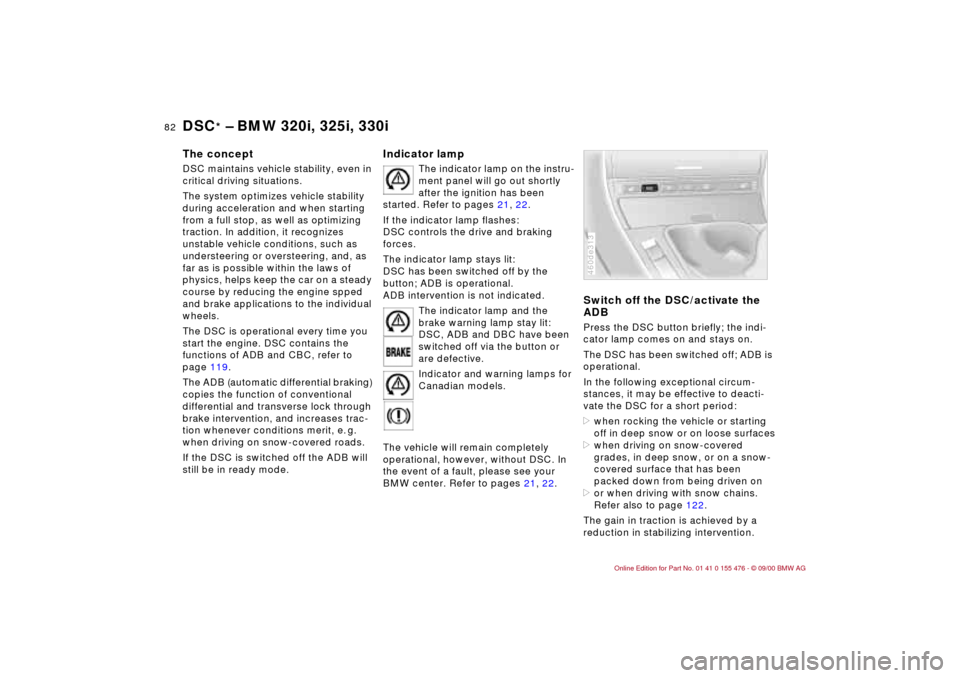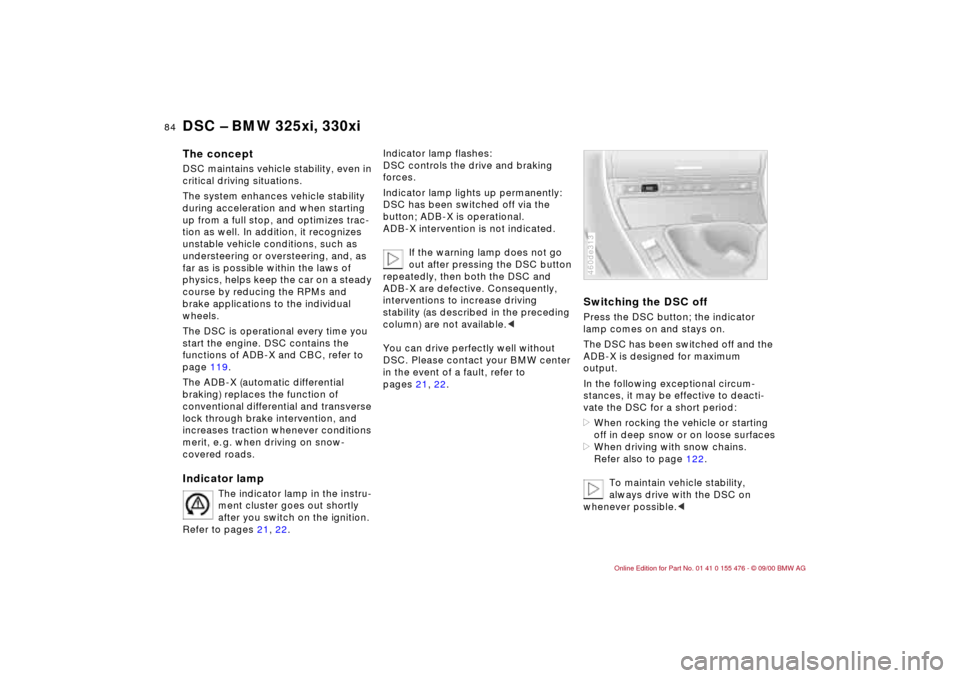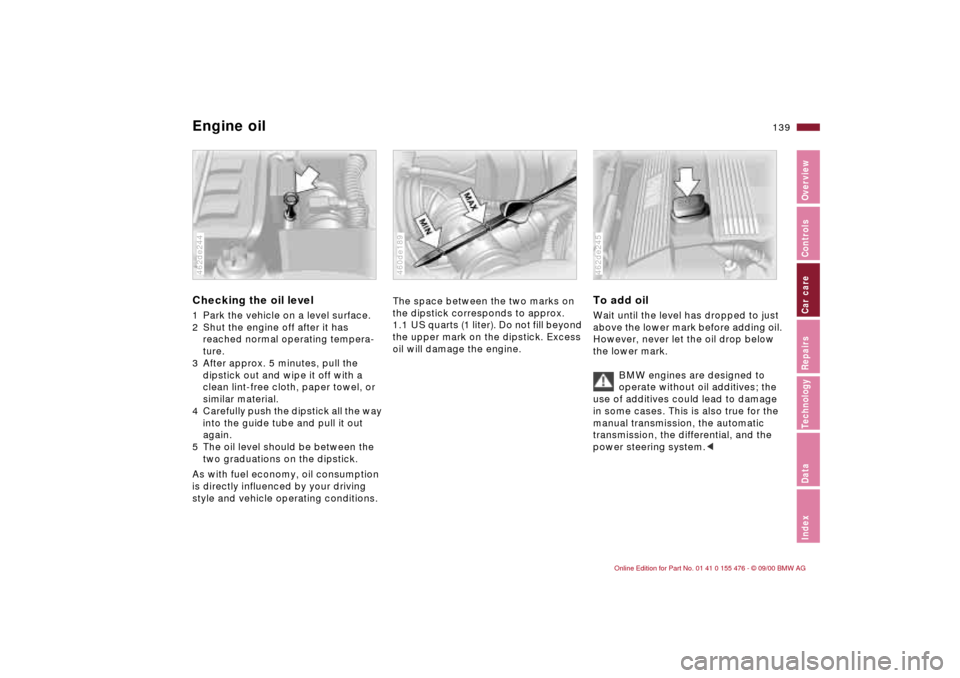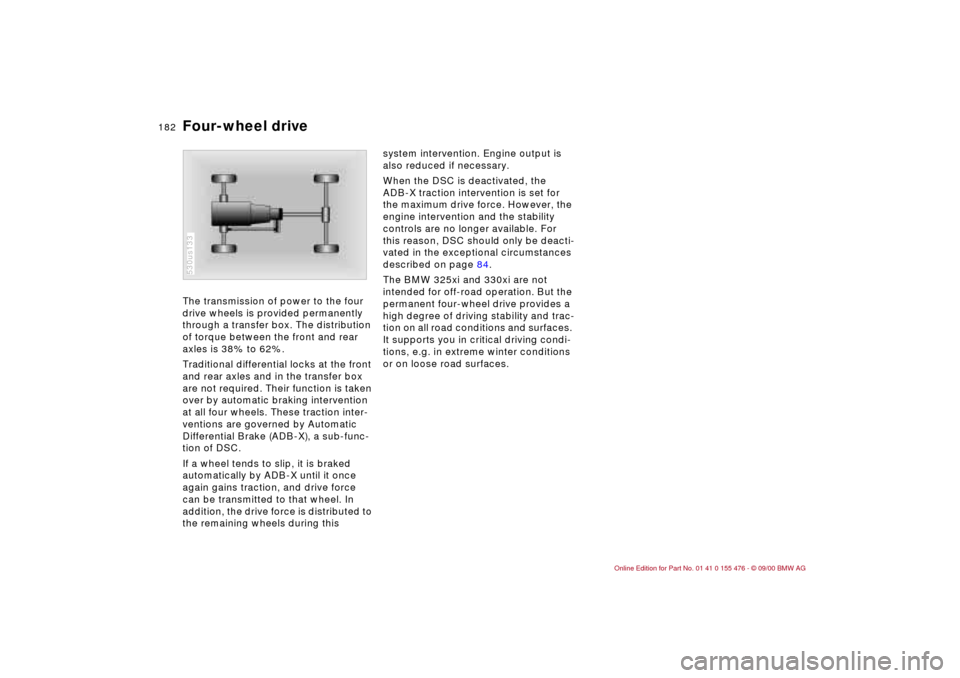2001 BMW 325i SEDAN differential
[x] Cancel search: differentialPage 82 of 211

82n
DSC
* Ð BMW 320i, 325i, 330i
The conceptDSC maintains vehicle stability, even in
critical driving situations.
The system optimizes vehicle stability
during acceleration and when starting
from a full stop, as well as optimizing
traction. In addition, it recognizes
unstable vehicle conditions, such as
understeering or oversteering, and, as
far as is possible within the laws of
physics, helps keep the car on a steady
course by reducing the engine spped
and brake applications to the individual
wheels.
The DSC is operational every time you
start the engine. DSC contains the
functions of ADB and CBC, refer to
page 119.
The ADB (automatic differential braking)
copies the function of conventional
differential and transverse lock through
brake intervention, and increases trac-
tion whenever conditions merit, e. g.
when driving on snow-covered roads.
If the DSC is switched off the ADB will
still be in ready mode.
Indicator lamp
The indicator lamp on the instru-
ment panel will go out shortly
after the ignition has been
started. Refer to pages 21, 22.
If the indicator lamp flashes:
DSC controls the drive and braking
forces.
The indicator lamp stays lit:
DSC has been switched off by the
button; ADB is operational.
ADB intervention is not indicated.
The indicator lamp and the
brake warning lamp stay lit:
DSC, ADB and DBC have been
switched off via the button or
are defective.
Indicator and warning lamps for
Canadian models.
The vehicle will remain completely
operational, however, without DSC. In
the event of a fault, please see your
BMW center. Refer to pages 21, 22.
Switch off the DSC/activate the
ADBPress the DSC button briefly; the indi-
cator lamp comes on and stays on.
The DSC has been switched off; ADB is
operational.
In the following exceptional circum-
stances, it may be effective to deacti-
vate the DSC for a short period:
>when rocking the vehicle or starting
off in deep snow or on loose surfaces
>when driving on snow-covered
grades, in deep snow, or on a snow-
covered surface that has been
packed down from being driven on
>or when driving with snow chains.
Refer also to page 122.
The gain in traction is achieved by a
reduction in stabilizing intervention.460de313
Page 84 of 211

84n
DSC Ð BMW 325xi, 330xiThe conceptDSC maintains vehicle stability, even in
critical driving situations.
The system enhances vehicle stability
during acceleration and when starting
up from a full stop, and optimizes trac-
tion as well. In addition, it recognizes
unstable vehicle conditions, such as
understeering or oversteering, and, as
far as is possible within the laws of
physics, helps keep the car on a steady
course by reducing the RPMs and
brake applications to the individual
wheels.
The DSC is operational every time you
start the engine. DSC contains the
functions of ADB-X and CBC, refer to
page 119.
The ADB-X (automatic differential
braking) replaces the function of
conventional differential and transverse
lock through brake intervention, and
increases traction whenever conditions
merit, e. g. when driving on snow-
covered roads.Indicator lamp
The indicator lamp in the instru-
ment cluster goes out shortly
after you switch on the ignition.
Refer to pages 21, 22.
Indicator lamp flashes:
DSC controls the drive and braking
forces.
Indicator lamp lights up permanently:
DSC has been switched off via the
button; ADB-X is operational.
ADB-X intervention is not indicated.
If the warning lamp does not go
out after pressing the DSC button
repeatedly, then both the DSC and
ADB-X are defective. Consequently,
interventions to increase driving
stability (as described in the preceding
column) are not available.<
You can drive perfectly well without
DSC. Please contact your BMW center
in the event of a fault, refer to
pages 21, 22.
Switching the DSC offPress the DSC button; the indicator
lamp comes on and stays on.
The DSC has been switched off and the
ADB-X is designed for maximum
output.
In the following exceptional circum-
stances, it may be effective to deacti-
vate the DSC for a short period:
>When rocking the vehicle or starting
off in deep snow or on loose surfaces
>When driving with snow chains.
Refer also to page 122.
To maintain vehicle stability,
always drive with the DSC on
whenever possible.<460de313
Page 116 of 211

116n
To ensure that your vehicle provides
maximum economy throughout a long
service life, we request that you comply
with the following recommendations.
Engine and differentialUp to 1,200 miles (2,000 km):
Drive at varying engine speeds and
road speeds, but do not exceed
4,500 RPM or a road speed of 100 mph
(160 km/h) during this initial period.
Obey your local and state maximum
speed limits.
Do not apply full throttle and avoid
pressing the accelerator beyond the
kickdown point.
After 1,200 miles (2,000 km), you can
gradually increase the engine speed or
road speed.
Follow the same break-in procedure if
either the engine or the differential is
replaced in the future.
TiresDue to technical factors associated
with their manufacture, tires do not
achieve their full traction potential until
an initial break-in period has elapsed.
For this reason, drive cautiously during
the first 200 miles (300 km).
Obey your local and state maximum
speed limits.
When the vehicle is operated on
wet or slushy roads, a wedge of
water may form between the tire and
the road surface. This phenomenon is
referred to as aquaplaning, or hydro-
planing, and can lead to partial or
complete loss of traction, vehicle
control and braking effectiveness.
Reduce your speed on wet roads.<
Brake systemBrake pads and disks do not attain their
optimal wear patterns until after approx.
300 miles (500 km).
To break-in the separate parking brake
drums, apply the parking brake lightly
when coasting to a standstill (at a traffic
signal, for instance), provided that
traffic conditions allow you to do so.
To avoid corrosion, repeat this proce-
dure from time to time.
The brake lamps do not come on
when the parking brake is set.
Vacuum for the brake system servo unit
on your BMW is available only when the
engine is running. When you move the
vehicle with the engine off Ð when
towing, for example Ð substantially
higher levels of pedal force will be
required to brake the vehicle.
(500 km). Engage the gears carefully
during the break-in period.
Break-in procedures
Page 139 of 211

139n
IndexDataTechnologyRepairsCar careControlsOverview
Engine oilChecking the oil level 1 Park the vehicle on a level surface.
2 Shut the engine off after it has
reached normal operating tempera-
ture.
3 After approx. 5 minutes, pull the
dipstick out and wipe it off with a
clean lint-free cloth, paper towel, or
similar material.
4 Carefully push the dipstick all the way
into the guide tube and pull it out
again.
5 The oil level should be between the
two graduations on the dipstick.
As with fuel economy, oil consumption
is directly influenced by your driving
style and vehicle operating conditions.462de244
The space between the two marks on
the dipstick corresponds to approx.
1.1 US quarts (1 liter). Do not fill beyond
the upper mark on the dipstick. Excess
oil will damage the engine.460de189
To add oil Wait until the level has dropped to just
above the lower mark before adding oil.
However, never let the oil drop below
the lower mark.
BMW engines are designed to
operate without oil additives; the
use of additives could lead to damage
in some cases. This is also true for the
manual transmission, the automatic
transmission, the differential, and the
power steering system.<462de245
Page 182 of 211

182n
Four-wheel driveThe transmission of power to the four
drive wheels is provided permanently
through a transfer box. The distribution
of torque between the front and rear
axles is 38% to 62%.
Traditional differential locks at the front
and rear axles and in the transfer box
are not required. Their function is taken
over by automatic braking intervention
at all four wheels. These traction inter-
ventions are governed by Automatic
Differential Brake (ADB-X), a sub-func-
tion of DSC.
If a wheel tends to slip, it is braked
automatically by ADB-X until it once
again gains traction, and drive force
can be transmitted to that wheel. In
addition, the drive force is distributed to
the remaining wheels during this 530us133
system intervention. Engine output is
also reduced if necessary.
When the DSC is deactivated, the
ADB-X traction intervention is set for
the maximum drive force. However, the
engine intervention and the stability
controls are no longer available. For
this reason, DSC should only be deacti-
vated in the exceptional circumstances
described on page 84.
The BMW 325xi and 330xi are not
intended for off-road operation. But the
permanent four-wheel drive provides a
high degree of driving stability and trac-
tion on all road conditions and surfaces.
It supports you in critical driving condi-
tions, e.g. in extreme winter conditions
or on loose road surfaces.
Page 195 of 211

195n
IndexDataTechnologyRepairsCar careControlsOverview
Capacities
Notes
Fuel tank
reserve gal. (liters)
gal. (liters)approx. 16.6 (approx. 63)
approx. 2.1 (approx. 8)Fuel specification: page 28
Windshield washer system/
Headlamp washer systemquarts (liters) approx. 5.6 (approx. 5.3) For details: page 138
Cooling system including heater circuit quarts (liters) approx. 8.9 (approx. 8.4) For details: page 142
Engine oil and filter change quarts (liters) 320i, 325i, 330i:
approx. 6.9 (approx. 6.5)
325xi, 330xi:
approx. 7.9 (approx. 7,5)BMW High Performance
Synthetic Oil
For details: page 140
Manual and automatic transmission, transfer
box and differentialÐ Lifetime fluid, no fluid change
required